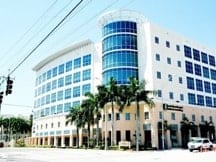Ankle Arthritis Surgery
What is ankle arthritis surgery? Ankle Arthritis is a condition where the ankle joint cartilage degenerates and becomes eroded, coarse, and stiff, with the potential to become enlarged and full of bone spurs. The ankle joint is responsible for up and down motion of the foot, and is made up of two leg bones (tibia and fibula) and one foot bone (talus). Ankle arthritis can be painful and interferes with everyday life.
Causes: Biomechanical problems and trauma-based injuries are the most common culprits behind ankle arthritis. Biomechanical imbalances such as flat feet or general lower extremity malalignment may wear out the ankle joint, resulting in premature degeneration. Traumatic injuries such as ankle fractures may damage the joint structure or create malalignment leading to arthritis. Inflammatory arthritis can also affect the ankle joint. Arthritis usually develops gradually over a long period of time, with frequent flare ups until a critical point is reached resulting in ongoing pain, swelling and/or discomfort.
Sign & Symptoms: Patients with ankle arthritis have varying degrees of symptoms, which often correlate with the extent of the arthritic degeneration. Typically, the symptoms involve pain, swelling and stiffness. Arthritic pain may flare after periods of inactivity, with the joint loosening up and the pain eroding as the day progresses. Ankle arthritis pain ranges from dull to sharp.
Movement of an arthritic ankle joint can result in a clicking or grinding sensation (crepitus). In unique cases, the ankle joint develops arthritic bone spurs – which is the body’s mechanism for blocking the painful arthritic motion.
Diagnosis and Treatment: Surgery for arthritis of the ankle varies depending on the location of arthritis, severity of arthritis, malalignment, and the presence of structural foot deformity (i.e., flat feet). In general, ankle arthritis procedures are separated in two kinds: Joint sparring (preserves the joints) or Joint destructive (eliminates the ankle joint through fusion or replacement).
- Joint Sparing Procedure.These procedures involve a surgical cleaning of the arthritic components of the joint(s) to alleviate pain and increase motion. These include: Arthroscopic Debridement, Exostectomy, Arthrodiastasis. These procedures are generally better indicated for mild to moderate arthritis. The benefit of the joint sparing procedures is that they are not final, and if it doesn’t resolve one’s symptoms to their desire, then more advanced procedures can be implemented.
- Exostectomy: Arthritic bone spurs can be removed through a procedure called Exostectomy. In the ankle joint, the arthritic bone spurs may form on the front of the ankle joint and become large spurs that block motion. When bone spurs limit motion, they grind and slam against each other, resulting in pain. Exostectomy allows for the arthritic joint to continue to move but is generally for mild arthritis. The recovery after exostectomy is also rapid as patients tend to be back on their feet after the procedure with little down time.
- Arthrodiastasis: This procedure involves invasive distraction to the ankle joint to offload the joint to promote cartilage healing. An external fixator (a metal circular device that bolts into the leg and foot bones) is used to provide the distraction which is worn for several weeks. This technique is used for varying degrees of ankle arthritis. This is the most aggressive of the joint sparing procedures, and because the surgery involves an external fixator, you may be immobile for six to eight weeks.
- Joint Destructive Procedures.Destructive procedures involve locking the joints in place by fusing or mending the bone. Joint replacements are also referred to as joint destructive procedures. The extent of the arthritis determines whether the ankle joint could be “saved,” and joint destructive procedures are necessary when end-stage arthritis is present, resulting in significant loss of the joint cartilage, bone cysts, arthritic bone spurs and/or bone cysts.
- Ankle Fusion (Ankle Arthrodesis): Ankle fusions are the most successful procedures for end stage ankle arthritis. The procedure involves removing the ankle joint is removed and the bones are mended together. An ankle fusion corrects any structural abnormalities of the ankle at the fusion site. Normally, the procedure requires inserting screws across the ankle joint to lock the position of the ankle. While the fusion eliminates motion, it also eradicates pain. Most people who require ankle fusion have already experienced many years of ankle stiffness with limited motion and have already adapted to a different gait and walking pattern so that locking the ankle in place with fusion does not typically adversely affect their walking, but has the added benefit of eliminating pain. The recovery for ankle fusion is typically six-to-eight weeks in a cast/boot with crutches until the bone mends. An ankle fusion is a permanent solution for ankle arthritis.
- Ankle Replacement: Also called ankle arthroplasty, this procedure utilizes an artificial metallic and/or polymer replacement of the ankle joint. The procedure allows for continued motion of the ankle, despite the limited range. Ankle replacement technology has advanced considerably since the last decade, with implants becoming smaller and more customized. Like any joint replacement, the implant has a limited lifespan and may require revision or replacement in the course of one’s life. The recovery for ankle fusion is typically 6-8 weeks in a cast/boot with crutches until the bone mends.
Recovery: Recovery depends on which surgery is performed. Arthroscopy and arthritic bone spur removal is much less invasive, and patients can usually walk after surgery. Ankle fusion and replacement protocols typically involve avoid any weight-bearing activities and require a cast and/or crutches until the bone mends – a process that can take six to twelve weeks.
Dr. Ray Lopez
Minimally Invasive Bunion Surgery

- Main Office:
- Miami Beach 400 Arthur
- Godfrey Road Suite #412
- Miami Beach, FL 33140

- South Miami
- 6200 Sunset Drive Suite #402
- South Miami, FL 33143

- Pembroke Pines
- 601 N. Flamingo Road
- Suite #101, Pembroke Pines, FL 33028

- Aventura
- 21000 NE 28th Ave.
- Suite #203, Aventura, FL 33180





